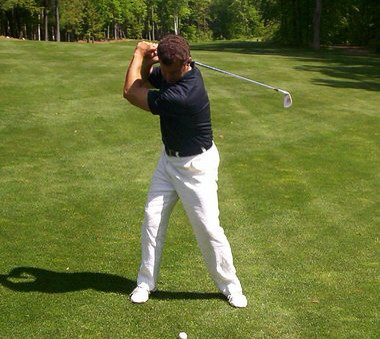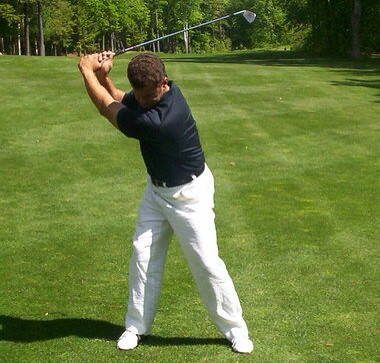 |
| Arms Collapsing |
One of my biggest golfing faux pas is collapsing at the top of my backswing. My right elbow has a tendency to pull the club back inside too quickly (too flat). Then at the top, in probably some unconscious effort to manufacture a longer swing and get the club parallel to the ground, my right elbow sucks in close to my right side--past 90 degrees--and my left arm collapses. As a result, I would get to parallel, but not like the pros do (through flexibility and athleticism); when I got to parallel, the club shaft appeared to be an inch or so from my right shoulder! It didn't feel this way during my swing, but it looked absolutely horrible in pictures and on video: My left elbow was almost at 90 degrees!!!
 |
| Correct Width |
My downswing then exhibited an over-the-top move and a flip at the bottom.
My teaching pro had me work on correcting the collapse by using a partially deflated rubber ball between my elbows as a drill to show me the correct feel for keeping my arms extended, wide, and in front of my chest during the takeaway and backswing. He told me that my elbows should maintain the same distance relationship (or near to it) at the top of my backswing as they did at address; the right elbow and arm should not be pulled behind oneself--an optical illusion we all think we see in the pros. The ball drill felt very strange indeed; it felt "wrong" to me. I had never really tried the correct feel, which feels shorter, compact, more linear, and vertical (and it really is because it's not as flat on purpose).
Something amazing happened when I watched video of me hitting a ball using the ball drill, besides the fact that I wasn't so collapsed at the top anymore; I had a flat left wrist at impact! A consequence of having a flying right elbow on the backswing, and sucking the club inside so far, was that my right elbow would crash into my right side on the way down--I was trapped! And the only way I could save the shot was to flip the club using my wrists! This made it clear to me--especially for an amateur hacker--that what you do on the takeaway and backswing CAN have a dramatic effect on what follows! (NOTE: Listen to your golf teaching pro!!!)
Many fine golf instructors have noted the importance of an extended left arm to create width in the backswing for power and consistency, and I believe the answer isn't the left arm itself: It's the right arm! The right arm should stay as extended as possible and push the club handle away from one's body, keeping the left arm straight passively. Pressure should be felt on top of the left thumb, and the right palm should face roughly up and to the rear at the top of the swing (as if the right palm is pushing the handle away from the target). The right arm should bend slightly (up to 90 degrees at maximum), but it shouldn't go below 90 degrees the way I was doing before, sucking the arms in close to the body and collapsing the left arm in the process. The hands can go as high as head level but shouldn't really go any higher, or the arms will disconnect from the body; also, the extension should only go as far as the left arm will allow while maintaining a slight bend in the right arm (again, ensuring no loss of connection). The club DOES NOT need to reach parallel to hit a powerful shot; don't worry about the pros who can reach parallel--they're pros and you're not!
This brings me to another point when it comes to addressing your swing problems: Don't be afraid to exaggerate a swing change, even if you might be overdoing it at first. You've got to give your body a new feel, and many great teachers such as Martin Hall, Hank Haney, and Butch Harmon advocate for exaggeration to ingrain a change in your game. As Martin Hall often says, "If you keep on doing what you've been doing, you'll keep on getting what you've been getting."
Coupled with maintaining a stable lower body (i.e., another of my errors was rotating my hips freely with my upper body) through torso rotation, I can consistently hit the middle of the club face this way. An overacting lower body can also contribute to sucking the club too far inside and its follow-on recovery moves of going OTT and flipping.
Another way to think of this: Try to keep your hands as far from your chest at the top as they were at address.
The second thing to consider is does the leading arm really bend on it's own? The answer is "no". It is the rear arm that pulls in. When your back arm collapses or pulls into your body, your front arm will naturally collapse. For this reason, our focus must be on the width that our rear arm is creating and maintaining.
If the arms travel across the body in the back swing, as is seen in many players, the club will be too far behind the body and it will take excessive hand rotation in the down swing to square the clubface. Conversely, if the arms move away from the body in the back swing the club will be above plane and the club will be returned on an outside to in path through the ball.To learn to correct role of the arms, place a soccer ball between your arms in your address position and take some practice swings. Make a back swing keeping the ball between your arms and in front of your chest. This will ensure that the arms stay connected to your body coil and they remain in front of your chest with good width. All the ingredients you will require to generate good club head speed.One of the staple tips we’ve heard over the years is “Keep your left arm straight.” By trying to do this, you could be preventing rotation and stalling your arm speed so why don’t we take the water skiing example and think of the lead arm like a rope where the roll of the right arm is to keep it tight – for the whole swing. There are a lot benefits to this including maintaining width in the arms, sequencing the arms with the chest, preventing the clubface from rolling open on the backswing, and creating just the right amount of lag on the downswing. Amateur golfers dream of lagging the golf club and in doing so create angles that are too much to control and ultimately can’t control them leading to the exact opposite at impact. Try going for an inch of lag instead of a foot.
At the top of the backswing, many amatuer golfers collapse their arms here as well. This is a crucial point in the swing where you want to make sure you have good extension and width. The right arm and elbow naturally folds as you swing to the top and your wrists are set and firm. The hands should also be a good distance away from your head or body. Collasping your arms will cause your hands to get too close to your head and you'll lose your golf swing width.
To increase width, you need to increase the spacing between your right hand and right shoulder (right-handed golfers) during your backswing.
Practice taking a backswing holding the golf club with just your right hand. Keep your right hand as far away from your body as possible during these practice swings. During this drill, reach your right hand toward the sky at the top of the backswing.
When Nick came to me, his hands were too active on the backswing, which made his swing arc narrow--a big killer of distance. The club got too far to the inside, so he would shift his weight away from the target on the downswing to get the club back in position to hit the ball.
I wanted Nick to feel his arms staying in front of his body as he turned back. We worked hard on building a backswing where his right arm and hand were as far away from his head at the top as possible. This gave Nick, who is 6-feet-2, tremendous width in his swing arc.
One of the biggest problems that many golfers have is an inability to generate and maintain sufficient width in their backswings.
That problem could be related to flexibility but it’s also possible that it’s just a swing flaw relating to issues such as a narrow swing arc, a takeaway that’s too flat or laid off, or just a complete collapse of the arms at the top of the swing.Because a swing change involves either a totally different motion or a wholesale change in your grip or setup, there's no way it should feel comfortable.The best way to make a radical change like that is to take slow-motion swings, sometimes exaggerating the movement. Then you repeat it over and over.